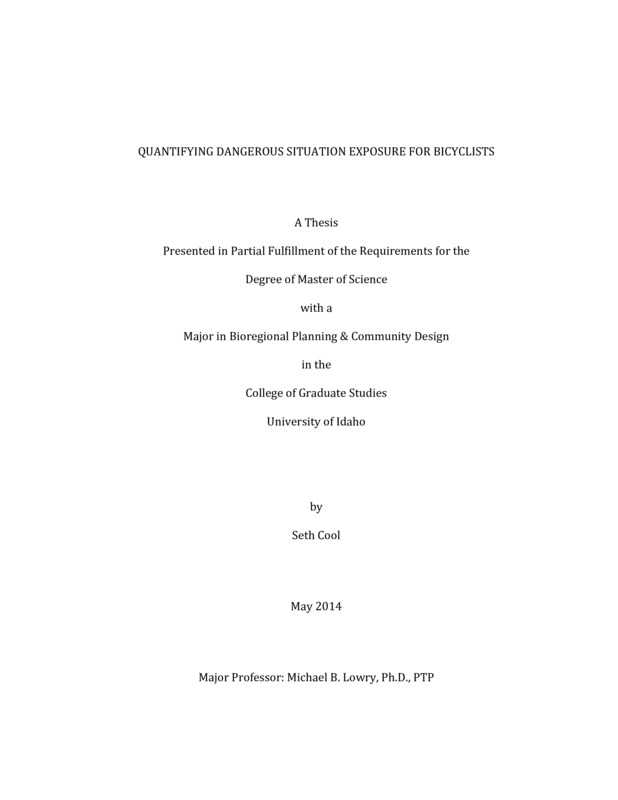QUANTIFYING DANGEROUS SITUATION EXPOSURE FOR BICYCLISTS
Cool, Seth. (2014). QUANTIFYING DANGEROUS SITUATION EXPOSURE FOR BICYCLISTS. Theses and Dissertations Collection, University of Idaho Library Digital Collections. https://www.lib.uidaho.edu/digital/etd/items/cool_idaho_0089m_10300.html
- Title:
- QUANTIFYING DANGEROUS SITUATION EXPOSURE FOR BICYCLISTS
- Author:
- Cool, Seth
- Date:
- 2014
- Keywords:
- accident exposure alternative transportation bicycle safety bicycle volume centrality demand
- Program:
- Bioregional Planning
- Subject Category:
- Transportation planning; Civil engineering; Public health
- Abstract:
-
This thesis introduces a new method to analyze network-wide bicycle infrastructure to quantify dangerous situation exposure for bicyclists. The method is intended for sketch-level scenario planning. Lack of bicycle volume data is a common impediment to calculating exposure, our method overcomes this by extrapolating short-duration citizen-volunteer count data to estimate community-wide bicycle volumes. First, the count data is extrapolated spatially using an origin-destination centrality technique. Second, the count data is extrapolated temporally using adjustment factors for hour, day, and month. This two-step extrapolation produces a rough estimate of Annual Average Daily Bicyclists (AADB) for streets, trails, and intersections across a community. Next, we propose using public participation to define community-specific "dangerous situation metrics" that can be used to compare AADB exposure for alternative improvement scenarios. We demonstrate the process with a case study by comparing exposure under current conditions and after implementing a proposed bicycle improvement master plan. For example, the case study showed a 5% decrease in AADB exposure to the dangerous right hook situation (bicyclists going straight through an intersection where there is a high volume of vehicles turning right). As another example, the improvement master plan was shown to potentially reduce the need for bicyclists to cross harsh intersections by 7%. The method introduced in this thesis can provide engineers, planners, and other decision-makers a means to compare improvement scenarios for investment decision-making. Furthermore, the literature review and discussion provides a starting point for communities to define their own dangerous situation metrics.
- Description:
- masters, M.S., Bioregional Planning -- University of Idaho - College of Graduate Studies, 2014
- Major Professor:
- Lowry, Michael
- Committee:
- Dixon, Michael; Chang, Kevin
- Defense Date:
- 2014
- Identifier:
- Cool_idaho_0089M_10300
- Type:
- Text
- Format Original:
- Format:
- application/pdf
- Rights:
- In Copyright - Educational Use Permitted. For more information, please contact University of Idaho Library Special Collections and Archives Department at libspec@uidaho.edu.
- Standardized Rights:
- http://rightsstatements.org/vocab/InC-EDU/1.0/

